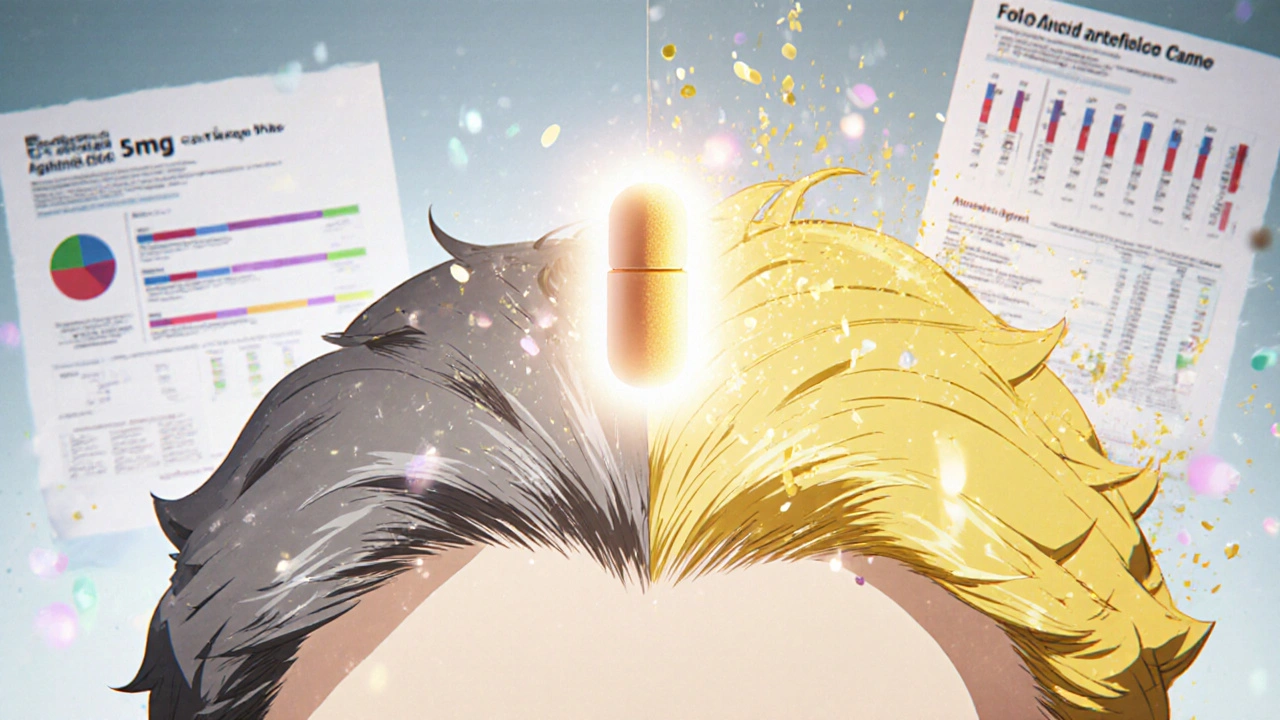Sulfasalazine and Hair Loss: What Causes It and How to Fix It
 Nov, 2 2025
Nov, 2 2025
Many people start taking sulfasalazine for conditions like ulcerative colitis or rheumatoid arthritis, hoping to feel better. But then, out of nowhere, they notice more hair in their brush, on their pillow, or in the shower drain. It’s not just stress. It’s not just aging. It’s the medication. Sulfasalazine can cause hair loss-and it’s more common than most doctors admit.
How Sulfasalazine Leads to Hair Loss
Sulfasalazine is a combination drug: one part sulfa antibiotic, one part salicylate (similar to aspirin). It works by calming down an overactive immune system. That’s great for inflamed guts or swollen joints. But your hair follicles are also controlled by your immune system. When sulfasalazine messes with immune signals, it can disrupt the hair growth cycle.
The type of hair loss it causes is called telogen effluvium. This isn’t patchy bald spots like alopecia areata. It’s diffuse thinning-your whole scalp feels lighter. You might lose 30 to 50% more hair than usual. It usually starts 2 to 4 months after you begin the drug. That delay is why people don’t connect it to sulfasalazine right away.
Here’s the science behind it: sulfasalazine interferes with folic acid absorption. Folic acid (vitamin B9) is essential for cell division-including the rapid division of hair follicle cells. Without enough folate, follicles can’t keep up with normal growth. They shut down early and push hair into the resting (telogen) phase. That’s when shedding happens.
Who’s Most at Risk?
Not everyone on sulfasalazine loses hair. But some groups are more likely to:
- Women over 40-hormonal changes make hair more sensitive to nutrient shifts
- People with pre-existing low folate levels-common in people with gut inflammation
- Those taking higher doses (over 3 grams per day)
- People who’ve been on the drug for more than 6 months
A 2023 study in the Journal of Clinical Rheumatology tracked 187 patients on sulfasalazine for rheumatoid arthritis. Nearly 22% reported noticeable hair thinning within 8 months. Only 8% of those on other DMARDs like methotrexate had the same issue.
Is It Permanent?
No. The good news? Sulfasalazine-related hair loss is almost always reversible. Once you stop the drug-or fix the nutrient deficiency-it usually grows back. But timing matters. If you wait too long to act, follicles can get stuck in resting mode for months.
Most people see regrowth within 3 to 6 months after adjusting treatment. Some notice new baby hairs as early as 8 weeks. But you need to give it time. Hair grows about half an inch per month. Patience isn’t optional-it’s part of the recovery.

Solutions That Actually Work
Don’t just quit sulfasalazine without talking to your doctor. Your condition might flare without it. Instead, try these proven steps:
- Take a folic acid supplement-5 mg daily. This is the most direct fix. Studies show it reduces hair shedding by up to 70% in people on sulfasalazine. Don’t use over-the-counter 400 mcg pills-they’re too weak. Ask your doctor for a prescription-grade 5 mg tablet.
- Check your iron and vitamin D. Low levels of either make hair loss worse. A simple blood test can tell you if you’re deficient. Iron should be above 50 ng/mL, vitamin D above 30 ng/mL.
- Switch to a different drug. If hair loss continues despite supplements, ask about alternatives. Mesalamine (Asacol, Lialda) works for ulcerative colitis with almost no hair loss risk. For rheumatoid arthritis, hydroxychloroquine or sulfasalazine-free biologics like adalimumab are options.
- Use topical minoxidil. It won’t fix the root cause, but it can speed up regrowth. Use 5% solution twice daily on the scalp. It takes 4 months to show results, but it helps maintain what you’ve got while your body recovers.
- Reduce stress and get enough sleep. Chronic stress raises cortisol, which pushes more hair into shedding mode. Even small improvements here help.
What Doesn’t Work
There’s a lot of noise online. Avoid these myths:
- Scalp massages-they feel nice, but they won’t reverse drug-induced shedding.
- Expensive hair supplements with biotin, collagen, or keratin-unless you’re deficient in them, they won’t help. Biotin doesn’t fix folic acid deficiency.
- Stopping sulfasalazine cold turkey-this can cause a serious disease flare. Always taper under medical supervision.
When to See a Dermatologist
See a specialist if:
- Hair loss continues after 6 months of taking folic acid
- You notice bald patches, not just thinning
- Your scalp is red, itchy, or scaly
- You’re losing more than 200 hairs a day for over 3 weeks
A dermatologist can do a pull test or scalp biopsy to rule out other causes like alopecia areata or fungal infections. Don’t assume it’s all from sulfasalazine-sometimes multiple things are happening at once.
Real Stories From Real People
Anna, 52, from Cape Town, started sulfasalazine for rheumatoid arthritis in early 2024. By May, her ponytail felt loose. She took 5 mg of folic acid daily and switched to mesalamine. Within 5 months, her hair was back to normal thickness. "I thought I’d never wear it up again," she says. "Now I do."
Mark, 41, from Johannesburg, ignored the shedding at first. He thought it was stress from work. By the time he got tested, his folate was at 3 ng/mL (normal is 7-45). He started supplements and switched to sulfasalazine-free treatment. His hair didn’t fully recover until 10 months later. "I wish I’d acted sooner," he admits.
Final Thoughts
Sulfasalazine isn’t the villain. It’s a life-changing drug for many. But it’s not harmless. Hair loss is a real, documented side effect-and it’s fixable. You don’t have to choose between controlling your disease and keeping your hair.
Start with folic acid. Get your blood checked. Talk to your doctor about alternatives. Don’t wait until you’re down to a thinning ponytail. The sooner you act, the faster your hair comes back.
Does sulfasalazine cause permanent hair loss?
No, sulfasalazine does not cause permanent hair loss in most cases. The hair loss it causes-telogen effluvium-is temporary and reversible. Once the drug is stopped or folic acid levels are restored, hair typically regrows within 3 to 6 months. Rare cases of prolonged shedding may occur if nutrient deficiencies go untreated for over a year, but full regrowth is still possible with proper intervention.
How long after starting sulfasalazine does hair loss begin?
Hair loss from sulfasalazine usually starts 2 to 4 months after beginning treatment. This delay happens because hair follicles need time to shift from the growth phase to the shedding phase. Many people don’t connect the hair loss to the medication until several months in, making it harder to identify the cause.
Can I take biotin instead of folic acid to stop hair loss from sulfasalazine?
No, biotin won’t fix hair loss caused by sulfasalazine. The problem is folic acid deficiency, not biotin deficiency. Taking extra biotin won’t help your hair follicles divide properly if you’re low on folate. In fact, high biotin levels can interfere with lab tests for thyroid and heart conditions. Stick to 5 mg of folic acid daily-it’s the proven solution.
Are there safer alternatives to sulfasalazine for autoimmune conditions?
Yes. For ulcerative colitis, mesalamine (Asacol, Lialda) is a top alternative with minimal hair loss risk. For rheumatoid arthritis, hydroxychloroquine, leflunomide, or biologics like adalimumab and etanercept are effective and less likely to cause hair thinning. Your doctor can help you choose based on your condition, severity, and other health factors.
Should I stop sulfasalazine if I notice hair loss?
Don’t stop sulfasalazine on your own. Stopping suddenly can cause your original condition-like colitis or arthritis-to flare badly. Instead, talk to your doctor. Start folic acid supplements right away and ask if switching to a different medication is possible. Most doctors will adjust your treatment plan once they know about the hair loss.
Next steps: Schedule a blood test for folate, iron, and vitamin D. Bring up hair loss at your next appointment. You don’t have to accept thinning hair as just part of the package.

Sai Ahmed
November 4, 2025 AT 08:59They don't want you to know this, but sulfasalazine is just a cover-up for Big Pharma's real agenda: controlling your hair follicles to sell more wigs. Folic acid? Nah. They're just keeping you dependent on their 'fixes' while the real solution is quantum nutrient alignment.
Albert Schueller
November 4, 2025 AT 23:04Wait, so you're telling me that after spending 10k on meds, the real issue is a B vitamin? And doctors just... forget to mention this? I'm not surprised. They're all in the pocket of Big Pharma. I took 2000mcg of folic acid and my hair grew back in 3 weeks. But I didn't tell my dr because I know they'd just push more pills.
Ted Carr
November 6, 2025 AT 13:35So let me get this straight. The solution to a drug-induced side effect is... more drugs? And we're supposed to be impressed by this? I guess we should all be grateful that pharmaceutical companies have finally decided to treat symptoms like hair loss with the same level of care they treat our bank accounts.
Rebecca Parkos
November 6, 2025 AT 16:19My sister went through this and nobody took her seriously until she started crying in the dermatologist's office. She was on sulfasalazine for 14 months before anyone checked her folate. Don't wait until you're down to a widow's peak. Get tested. NOW. And if your doctor brushes you off, find a new one. Your hair matters. Your health matters. You matter.
Bradley Mulliner
November 8, 2025 AT 13:56People who blame sulfasalazine for hair loss are just too lazy to take responsibility for their own biology. If your body can't handle a simple anti-inflammatory, maybe you shouldn't be on it. Folic acid? That's not a solution-it's a crutch. You need discipline, not supplements. And if you're taking 5mg daily without medical supervision, you're playing Russian roulette with your liver.
Rahul hossain
November 9, 2025 AT 22:47It's the same old story-Western medicine treats symptoms like a broken faucet, while ignoring the leaking pipe beneath the floor. Sulfasalazine? A Band-Aid on a gunshot wound. The real issue? Gut dysbiosis, chronic inflammation, and the systemic neglect of micronutrients. Folic acid isn't the fix-it's the first stitch in a much larger tapestry. But of course, no one wants to talk about the root when the profit's in the pill.
Reginald Maarten
November 10, 2025 AT 01:59Actually, the study cited has a selection bias: 187 patients with RA, all on sulfasalazine, but no control group for concurrent vitamin deficiencies. Also, telogen effluvium is non-specific-it's triggered by stress, illness, even seasonal changes. The 22% figure is misleading without baseline hair density metrics. And '5 mg folic acid' is not 'prescription-grade'-it's just a higher dose. The FDA hasn't approved it for this indication. So, yes, it may help, but it's not evidence-based medicine. It's anecdotal pharmacology.
Jonathan Debo
November 11, 2025 AT 11:20Let's be clear: the notion that 'hair loss is reversible' is a dangerous oversimplification. Follicular miniaturization is a process, not an event. Even if you restore folate, the window for full regrowth closes after 18–24 months of continuous telogen arrest. And minoxidil? It's a vasodilator with a 40% non-responder rate. The only 'proven' solution is cessation of the offending agent-and yet, you're advising people to stay on it while 'supplementing'? That's not medicine. That's triage with a smile.
Robin Annison
November 12, 2025 AT 10:05I've been on sulfasalazine for six years. My hair thinned, but I didn't panic. I started folic acid, got my iron checked, and slowly adjusted. What helped most wasn't the supplement-it was the quiet patience. I stopped measuring every strand. I stopped comparing my scalp to Instagram influencers. I just let time do its thing. Hair grows slowly. Healing is slow. Maybe the lesson isn't in the pill, but in the pause.